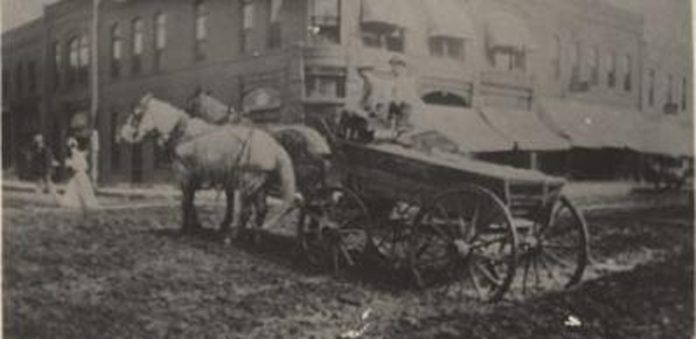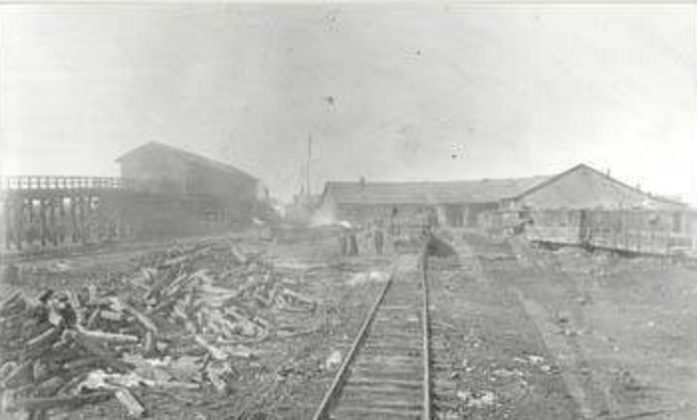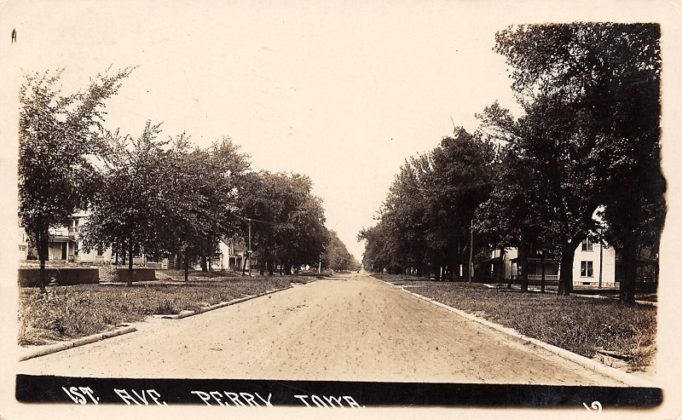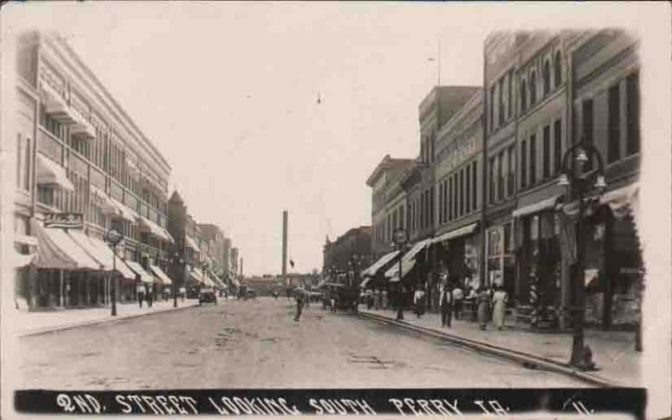
During the summer of 1891, Perry Mayor Allen Breed and the Perry City Council decided to put in a waterworks system. On Aug. 4, 1891, the council sold $9,500 worth of municipal bonds to finance the construction.
In the fall a deep well was dug, and a pump-station was built at W. Fourth and Warford streets. A stand pipe was also put up and water mains laid on a few streets. For some reason, the city then sold the system to David Pattee for $7,500 on Sept. 7, 1891, and thereafter leased the plant for six years at $750 a year.
The city leaders then bought the waterworks back from Pattee, and the system remained publicly owned ever since.
Later on, water was piped to all parts of town for family use and fire protection. In spring 1953, a new water tower was put up and the old water stand taken down after 62 years of service.
Before the coming of electricity in 1892, Perry streets were lighted by kerosene lamps. Each morning the lamps were tended by an old man whose name is now forgotten. Maybe it was Bernie. He had a push cart equipped with a short ladder, kerosene, wicks, burners and some cleaning rags, and he made his daily rounds faithfully. In the evening, a boy made the rounds, lighting all the lamps in town on a pony furnished by the city.
During the dry, dusty days of summer, Dave Willis used to sprinkle the streets with his sprinkling wagon, pulled by his team of black horses.
The first addition to the town was the Otley Addition on the south, sometime called Evergreen Hill. The next one was Miller’s Addition on the north. When the old fairground was discontinued and the lots sold, it was named Highview Addition.
D. J. Pattee owned 40 acres west of Frog Creek and north of Willis. In 1913 this was annexed to the city under the name of Pattee Riverview Heights. One of the biggest additions was that of B. C. Dillenbeck beginning in 1912.
At this time the Milwaukee roundhouse and shops were to the east. The Shorthill Steel and Iron works were building a large plant to the northeast, and the Milwaukee was planning a great expansion.
The first Dillenbeck Addition of 22 acres was located west of 16th Street and 40 acres east of 16th Street. The second 20 acres was south of Willis Avenue, and a third addition of 82 acres was a little farther out. The ground was annexed to the city under the name of the Dillenbeck Additions.
Streets were graded and sewer and sidewalks put in. About 50 new homes were built, a lumber shed erected and lumber hauled in by the carload. By September an auction was held to sell the homes to the public.
The houses, in all stages of construction, were scattered over most of the area, but all were laid out on streets, with sidewalks, sewers, young trees and other amenities. Some homes were sold, but many were not. It was objected that it was a mile or so from downtown.
To fix this, Dillenbeck promised to built a street car line. On July 14, 1912, a franchise was granted to him to build the line, but it was never done, although a carload of railroad ties were purchased and piled on the grounds.
The Perry Town Lot and Investment Co. was incorporated, with Dillenbeck owning most the stock, but to the surprise of all, the Millwaukee moved far to the west of town, and the Shorthill plant never got beyond the construction stage, leaving the area quite unattractive.
For many years, Second Street was cut in two by an electric light plant built across the street at Otley Avenue, but in 1916 a new one was up and running, and the one power plant was abandoned and torn down.
The problem was the old foundation still remained, and people on south Second Street had to use First or Third to get to town. Not until 1920 was this taken care of and in doing so, part of the Allgood building that extended too far to the east was also removed.
The first pavement in Perry was laid 1910 under the leadership of Mayor Modlin. In that summer, First and Willis avenues were laid with five-inch-thick wooden blocks of long-leaf pine shipped in from Alabama and set on a concrete base. A tar preparation was poured over the wooden blocks that was supposed to make them water tight.
But after a few years, water got in and swelled up the blocks, causing them to rise up sometimes a foot or more and making for hazardous driving.
The first street signs were erected in 1908 as the city was getting ready for citywide mail delivery. The signs bore white letters on a blue background and were fastened to electric light poles at streets corners.
About 1950 they were replaced by others mounted on a iron pole set in concrete. This was about the time that a mercury vapor system of lighting was put in downtown.





















Informative article. Thanks.
Interesting. Love reading about and learning history of Perry. Thanks, Brent Hegstrom! I would appreciate it if Brent could contact me. We grew up together as neighbors, and I am searching for a picture of his grandparents. Thank you.